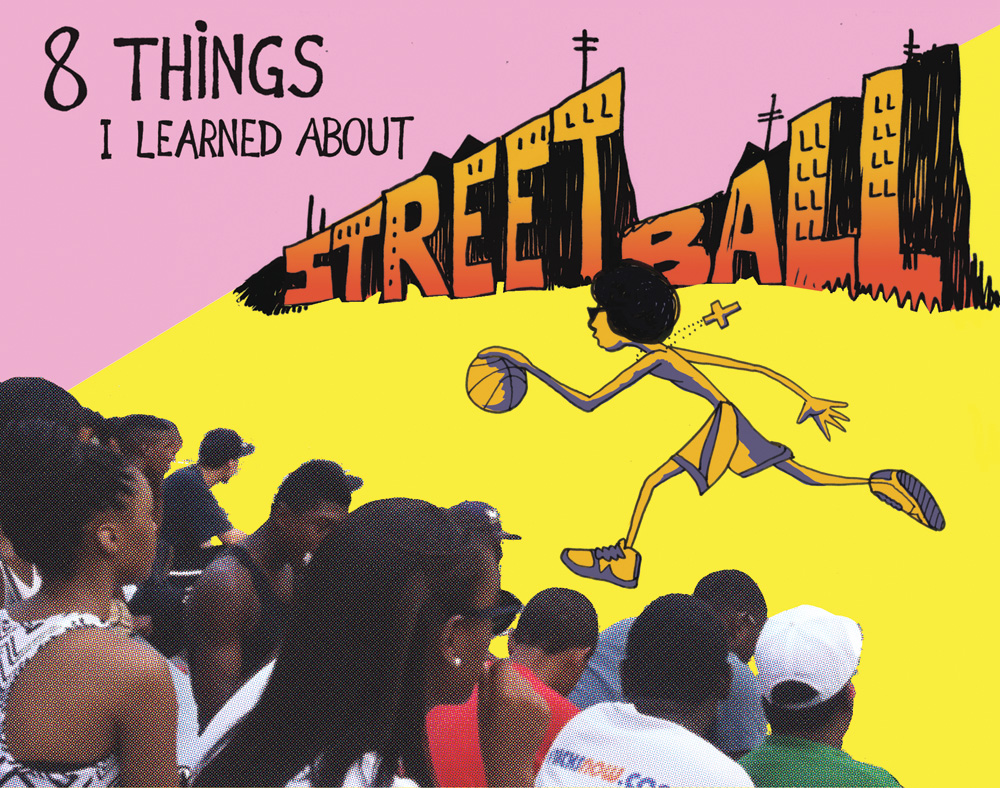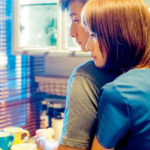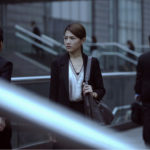WRITER – Rick Kang
CN – Belinda
ILLUSTRATOR – Rob Judges
Full disclosure: even though I lived in New York backintheday (‘98/’99) and even played ball in the streets of New York, up until this July I’d never actually watched a basketball game in New York. The Knicks? First off, I hate ’em. I hated them in the Patrick Ewing/John Starks era, rooted (briefly) for them as an underdog in the short-lived Sprewell era and they’ve been pretty much irrelevant ever since.*
* Yeah, yeah, Carmelo. As for Brooklyn – the Nyets? Seriously? Maybe this year; maybe…
(English continued after Chinese)
提起紐約,或者當年的hip hop風光不再,但紐約街頭籃球的王者霸氣至今依然未減。
利申:雖然我在紐約住過一會兒(1998-1999),又打過一陣街頭籃球,但是我其實沒有真正看過一場籃球賽。你想應該有看過the Knicks吧? 不要開玩笑,我討厭這支球隊,除了因為它的影響力小之外*,我也討厭Patrick Ewing/John Starks擔正的年代,我只算是勉強支持過苟延殘喘的Sprewell年代,就這麼多而已。
*我知道,我知道有Carmelo。所以你說要去看布魯克林the Nyets?你還在開玩笑嗎?好吧,或許今年去,又或者…不會。
總之,雖然我住的紐約有Rucker和其他數不盡的街頭籃球聯賽(例如:布魯克林的Soul in the Hole, 西四街的The Cage, 因伍德的Dyckman),但是我從來沒有見識過為人津津樂道的熱血街場比賽。於是在上個週末,我決定是時候要去長見識了。
我本來打算去哈林的Rucker Park, 可惜來得不是時候,沒有碰上比賽--誰都想免掉查找聯賽比賽場次的功夫啊。不過也沒關係,我轉去有著街籃傳奇Bobbito Garcia的Dyckman街籃聯賽,剛好碰上了星期五晚上演的兩場高中比賽,分別是:L-Pac 對 Mookie’s All Stars, 以及Team Dyckman對10th Avenue。
來到哈林,如果你和我一樣是個「sneaker痴」,就別忘了去Footlocker House of Hoops的分店朝聖,搶一雙剛推出的人氣鞋作Rondo Christmas PE Hyperposites,來個完整的紐約籃球體驗。[https://www.facebook.com/pages/HOUSE-OF-HOOPS-HARLEM-NEW-YORK/296798495932]
還有給大家一個忠告,就算做個旅客在哈林玩,也不要拿著一個15‘’x20’’的大鮮橙色Nike鞋盒四處閒逛,太像個呆瓜了。買了心愛的鞋子就趕快把盒子扔了吧,說我是自作多情,或者什麼也好,反正我在Marcus Garvey公園扔了盒子後(公園在第120街和Madison大街旁邊),馬上自我感覺良好。
去因伍德Dyckman的路上,碰見了一個青籃的聯賽,場地附近還掛滿了各種口號標語,不少還是由署名「哈林市市長」(“Mayor of Harlem”)發起的,宣揚各種要保護孩子,避免他們變成街童或加入黑社會的正面信息。說來也巧,上世紀80年代的紐約市毒梟Alberto “Alpo” Martinez 剛好也有“Mayor of Harlem”的別稱,我心想不會就是他吧?我還真不知道,也不想問啊。看一群12歲左右的小孩子打籃球,打得不華麗,但是充滿活力和幹勁,正好作為我的紐約街籃之夜的前菜。
走得大汗淋灕,手上拿著用白膠袋包著價值250美金新球鞋(喂,白膠袋比鮮橙色大鞋盒低調多了),心情緊張地來到Dyckman球場。奇怪的是,真正見到Dyckman之後卻又不緊張了。球場的兩邊是看台,大概可以坐六行觀眾,還有幾個警察懶懶閒地巡邏。有不少人一早來了佔位置,大多是住在附近的居民,當中主要是年輕的小伙子,還有很多孩子,也有一家大小來的,餘下的就是我和朋友,及幾個黑人和拉丁美洲人。走近看台的時候,Dyckman的場地保安還打趣地謝謝我送他一雙新球鞋,好險沒有真搶我的寶貝,我就當他開玩笑了--心想還好他穿13號,我捧著的只有11號半。
天氣不是一般的熱。攝氏40度的熱浪包圍著整個城市,又熱又濕,密不透風。我和朋友趕緊攔下了賣冰鎮可樂的女孩,可樂一瓶也就1美金。看台上陸陸續續地多了婦女們拿著鋁製的托盤,盛著各種風味小吃四處走動販賣,常見的有串燒牛肉和賣2美金一個的Empenadas。Empenadas看起來像炸得金黃的大餃子,厚厚的邊緣炸得略脆,連著用料十足的熱辣辣牛肉和芝士餡料大口咬上幾口,再灌瓶冰凍凍的可樂,解饞消暑暢快!
吃飽喝足後,環顧Dyckman球場,這裡看起來實在很「紐約」。球場左邊是紐約典型啡色磚頭公寓,右邊是噪音不斷的市内鐵路。球場的大小應該只有正規場地的四分三,或許更小,兩頭是透亮的Plexiglas籃板和籃筐。圍著球場的鐵絲網掛著有點舊的Nike「我們是Dyckman」橫額和其他汽車維修公司、藥品公司、雪糕、飲品等廣告標語;球場後頭的角落放著飲品公司贊助的記分板,球場中間有比賽計分員和一堆DJ音樂器材,他們的左右分別是兩隊的地盤。
說說賽事。第一場L-Pac 對 Mookie’s All Stars看得人生悶氣,一坐下馬上就連續四個冒失、粗心的擲界外球,就算我本人很粗心大意,但也不會犯下類似這樣毫無技術含量的擲界外球啊。好啦,可能是慢熱的隊伍,那就等等吧。可是等到最後的五分鐘,理論上的最後機會,最拼命的時間,但實際上這群高中生還是在拖拖拉拉,愛打不打的。這場比賽好像打了幾個世紀才完,看得人心身煎熬,累人啊。唯一有趣的地方是完場的時候,DJ Khaled播「乾淨版」的歌曲,居然屏蔽了不雅用字,可見Dyckman多麼顧及跟著家長來的小朋友和其他看球的小伙子們啊,可惜的是,碰巧那首歌的髒話和不雅用語尤其多,最後變成了嗶-嗶嗶-嗶之歌。
看著第二場比賽的隊伍Team Dyckman和10th Avenue的隊員熱身,我有預感好戲終於要上演了。看他們的風度和身形就知道他們和普通的高中生不同,他們更成熟、更強壯。我注意到黑隊有一位個子特別高的球員,將近有6‘10’‘。他穿著一雙Nike Christ the King版本的LeBron Soldier 6s。(Christ the King可以說是紐約市最為神聖的籃球高中,而“Soldier”系列可以算是LeBron專業球鞋系列的「平民版」) 我還發現以球鞋種類和數量計算,整個球場幾乎都是Nike的天下。第一場比賽除了出現過一雙Under Armours之外,其餘的全是Nike(就是Jordan系列的鞋)。到了這場,也不過是多了一個小子穿著雙好像是Micro G系列Brandon Jennings的Under Armours和幾雙Adidas。
本來就已經很興奮的評述員,來到這時更激動。他是個相對矮小的黑人,穿著寫有”CHA-CHING”(跟收銀機的”CHA-CHING”聲效一樣)的白T-shirt和短褲,再配一雙耀眼的全紅色Air Jordan (V) Air Force 1s。後來知道他除了穿著”CHA-CHING”,名字原來也叫”CHA-CHING”,而且每當有進球的時候,他總會立刻配上”CHA-CHING”的聲效。我這才發現,淡定原來也是美德。CHA-CHING 在開賽前,眉飛色舞地吼著介紹這兩支隊伍是有著世仇的高中精英隊伍,在比賽途中甚至一邊滔滔不絕地評述,身體一邊跟著籃球上下上下地晃動之餘,還不忘感謝贊助商,很專業。
這場比賽明顯比第一場要刺激得多,實力旗鼓相當的對手,明快的節奏彌補了一些技術上的不足。那個穿Under Armours的小子表現很亮眼,他長得很瘦,貌似有半黑人和半拉丁美洲人的血統,CHA-CHING笑稱他為 “Apoca’lyto”, 應該是指他像06年上映的賣座電影“Apocalyto”《啓示錄》的瑪雅人男主角般英勇吧?CHA-CHING還喜歡幫其他球員起別名,例如什麼「雙雙先生」、「壽星公」。後來,那個我之前提過的快7尺高的小伙子“Adonis” [http://sports.yahoo.com/ncaa/basketball/recruiting/player-Adonis-DelaRoas-141474]連續搞砸了幾個補籃之後,CHA-CHING馬上叫他做「無法入球」,引得觀眾哈哈大笑。
在這個沒有風又熱得讓人窒息的夜晚,跳投的不多,連灌籃的也很少,屈指可數的幾個灌籃還是在拉得很開的快攻或者是籃底妙傳的配合下才出現。我猜這與很多人想象中的街籃﹣﹣隨時一眨眼就有一個灌籃的情景不同。整場比賽最精彩的不是跳投,不是灌籃,反而是封阻。這裡的封球不是那種常見的勉強用手指尖碰著球的所謂封阻,而是忽然不知道從哪裡蹦出來,然後高高跳起像排球扣殺一樣,一下猛擊把球封殺的封阻,精彩!
Dyckman隊在“Apoca’lyto”的帶領下,試圖在比賽的倒數階段組織一個迅猛的反攻。還剩15秒完場,落後兩分,來一個漂亮的三分球就能反敗為勝。傳來了一個俐落的邊線球,“Apoca’lyto”接到了傳球,迅速地跳高,準備射入決定勝負的三分球,籃球離手向籃筐飛去,所有觀眾屏息而待,盯著球的軌跡,準備在入球的瞬間爆發出最熱烈的歡呼,然後…球射歪了,沒入籃,夠反高潮的。反觀對手10th Avenue隊終於鬆了口氣,贏得驚險。
比賽完,CHA-CHING又吼著介紹穿著運動短褲和人字拖的Russ Smith,這個來哈林遊玩的男孩是應屆高校NCAA男子籃球聯賽冠軍隊Louisville Cardinals的隊員,還說Russ會打下一場的街籃。不過,我沒有留下來,因為已經晚上十點了,我真不覺得比賽還會繼續。[http://dyckmanpark.ning.com/page/college-pro-division-1]
看過紐約街籃,確實長知識了。首先,終於知道了紐約街籃就是體力活。每一次的切入都要扛住對方的手、手臂和整個身軀,拉開,切入,好不容易再拉開,對手又纏上來…辛苦地用汗水換來每個入球。所以如果你能在紐約的街籃場上不丟球,你在世界其他籃球場上也不會丟球。當然,進球就是另一回事了。
(English Con’t)
My original mission was to catch a game at hallowed Holcombe Rucker Park (a.k.a. the EBC) in Harlem – where guys ranging from the venerable Doctor J and Wilt Chamberlain to 90s icons such as Allen Iverson and Kobe Bryant have played the city game. But the EBC’s schedule didn’t match mine, so I quickly switched gears to the Dyckman, a tournament I’d only heard and read about courtesy of New York b-ball historian Bobbito Garcia. Sure enough, there were two high school division games scheduled Friday night: L-Pac vs. Mookie’s All Stars and Team Dyckman vs. 10th Avenue. I also caught the final quarter of a Pro/Am game at the Cage (at West 4th) – and here’s what I learned.
1. Just because it’s streetball doesn’t necessarily mean it’s street
Before we went up to the Dyckman, my friend and I stopped through Harlem, home of the late Lamont Coleman – a.k.a., Big L (the greatest deceased rapper of all time. Yeah, I said it). And while 1-3-9 and Lennox may have once been the “Danger Zone”, it isn’t nearly so dangerous now.
Of course, no trip to Harlem is complete without a stop at the Footlocker House of Hoops [link to: https://www.facebook.com/pages/HOUSE-OF-HOOPS-HARLEM-NEW-YORK/296798495932]. The Rajon Rondo PE Hyperposites had just dropped, and being the hopeless sneaker junkie I am, I had to have them. Of course, this being Harlem and me being a tourist, I felt immediately like a trick-ass mark walking around with a giant orange Nike shoe box-sized target in my hands. Whether my paranoia was justified or hopelessly fuelled by racism, I felt much better once I dumped the box at Marcus Garvey Park (120th St. and Madison Ave.) and wrapped the sneakers casually in the giant white plastic bag them came in.
Once I got to Dyckman, I realized my paranoia was just that. A handful of NYC’s finest chilled behind the caged courts by their prowl cars, augmented by Dyckman’s own security. The atmosphere was genial and chill (relatively speaking, considering it was a humid, muggy 40°C/100°F). The rows of bleachers on either sides of the court and along the baseline were filled primarily with children, teenagers and young folks, with a sprinkling of families and random others (that would be me and my buddy – two of the few non-Black or Latino spectators).
How chill, exactly? So chill that I smelt copious amounts of weed smoke in the air once the sun went down – without a hint of po-po persecution. The most I got sweated was by the Dyckman security guard, who playfully thanked me for grabbing him a pair of kicks. I say “playfully” because he didn’t then snatch them from my grasp. Besides, he was a size 13 – mine were 11 ½.
2. It may be a game – but they ain’t playin’
All the games I saw – the two high school division games at the Dyckman and the Pro/Am game at the Cage – may have lacked crisp execution, but they more than made up for it in intensity. And just because basketball isn’t a contact sport doesn’t mean it ain’t physical. Even during the high school games, there was plenty of hand-checking, banging and contact on nearly every play in the paint (and a foul for every paint-possession, if you believed the players’ complaints).
While everyone thinks of streetball as showboating, dunks and highlight-reel blocks, it’s also maaaaad prideful. What’s that mean? Barring fast breaks, it’s single coverage: man-to-man defense – which means if you don’t want to be embarrassed you’d best check your man good, because there’s no guarantee of help behind you.
Having said that, the plays that got the crowd most amped were the blocks – emphatic rejections (usually from behind) that had more in common with volleyball spikes that basketball plays. They easily drew the most “oohs” and “aahs” from the assembled masses, ourselves included. Of course, that may have also been because there weren’t any havoc-inducing dunks to bring us to our feet.
Gameplay mainly consisted of guys clearing out and beating (or attempting to beat) their man off the dribble en route to the rack. Everything else – turnovers, offensive rebounds, swats and fast breaks – stemmed from there.
I’d also be remiss if I didn’t mention that the first game we’d wandered into – a High School Division game between L-Pac and Mookie’s All-Stars [link to: http://dyckmanpark.ning.com/page/high-school-division-1] – was a thoroughly sloppy affair. I know they’re high school kids, but I was amazed at the laissez-faire attitude given there were only five minutes left on the game clock. From the moment we sat down we witnessed at least four inbound passes that ended up as turnovers – back-to-back-to-back-to-back.
Seriously – it wasn’t suffocating, double-teaming, swarming defenses that that caused them, either. Just careless, clueless, aimless inbound passes. I was incredulous because even I don’t make inbound passes that crappy (and I’m known to be fairly casual with the ball).
3. “Operate!”
One of the unexpected highlights of visiting the Dyckman was the skinny guy in white tee, white Air Jordan (V) stenciled-shorts and all-red Air Force 1s trailing the action – a.k.a. Cha-Ching (because that what he’d say after every mad basket – and also what was written on his shirt), a combination of Marv Albert and Marley Marl, providing play-by-play and color commentary.
Of course, this is a long-running New York City (and I guess the rest of U.S. streetball leagues, too) tradition. I’ve never seen a game at the Rucker, but I do know that the emcee duo who comment on the action are known as Tango & Cash (and they’re neither Sly Stallone nor Kurt Russell). West 4th had an emcee, too, but he kept his commentary more on-topic than Cha-Ching.
The second Dyckman high school game, as Cha-Ching constantly told us, wasn’t just your run-of-the-mill summer league contest. “Braggin’ rights…”, he’d remind us. “You ain’t make the playoffs, win this game and it’s braggin’ rights…” The teams – Dyckman and 10th Avenue, separated only by a strip of road – apparently had a grudge that eclipsed even the grandeur of Dyckman basketball.
“High school division; Ultra-Elite!” Cha-Ching would shout sporadically as he followed the action up and down court (literally). During gameplay he’d both encourage and admonish; urge players to “Isolate!”, “Operate!”, “Clear out!” and “Put food on the table!”; all from a cordless mic as he casually strolled up and down the court.
While Cha-Ching would intone the nicknames of several players throughout the affair – “Vince, a.k.a. Mr. Double-double!”; “You go, Birthday Boy!” – it was the lilting tones of “Apoca’lyto” I’d remember the most. “Apoca’lyto”, of course, being a skinny half-Black, half-Latin looking-kid with impeccable handles who was also wearing the highest pair of high cut sneakers since Woody Harrelson’s character Billy Hoyle rocked the Command Forces in “White Men Can’t Jump” [link to: http://www.complexmag.ca/sneakers/2011/07/the-50-greatest-sneaker-moments-in-movies/the-chump-wears-command-forces] – the Under Armour Micro Gs. It seemed the first half was mainly “Apoca’lyto” breaking down his man off the dribble and taking it to the rack or making plays from there.
When he wasn’t instructing players to “operate!”, Cha-Ching would occasionally take the time to thank sponsors, shouting “Nike on deck! Dunk’n Donuts on deck! Dyckman Car Service on deck!” – but his primary discourse was the game. And the second high school contest was a good one.
4. Basketball is a village
Basketball may be an increasingly global game, but even in a city as big as New York it’s still a small community. I’d read about this before from writers such as Rick Telander in Sports Illustrated, who wrote about 90s-era NYC ballers such as Charles Jones (of L.I.U. fame, and NCAA Division I scoring champ to boot). I remember Jones saying he’d spend the summer traveling from game to game across the city. And with so many tournaments and leagues across the five boroughs – from Harlem’s Rucker to Brooklyn’s Soul in the Hole to the Dyckman in Inwood to all the others I’ll never hear or know of – it’s likely only possible in New York.
While the Pro/Am game at the Cage at West 4th was going on, I noticed “Apoca’lyto” from the previous night’s Dyckman tilt waiting for his time to shine. Even the ref of the first Dyckman game – an older gentleman with the world’s largest knee brace – was whistling the action at West 4th.
Even the youngbloods start early. Prior to hitting the Dyckman, we passed a biddy-ball tournament in Harlem. The banners by the sides of the court spouted positive messages about giving kids something to do and keeping them off the streets. To top it all off, this tournament was brought to the masses by “The Mayor of Harlem”, according to the banners. Did they mean the 80s NYC druglord Alberto “Alpo” Martinez? [link to: http://www.biography.com/tv/gangsters-americas-most-evil/episodes/the-mayor-of-harlem-alberto-alpo-martinez] I honestly don’t know – and I didn’t ask.
As for the ball? The kids looked young – most under 12, and the gameplay was exuberant if not always aesthetically pleasing. In that regard, it wasn’t really all that different from the grown-up versions these kids might be playing in soon enough.
5. You WILL get called out
Between encouraging and instructing, Cha-Ching would also point out players’ weaknesses and flaws. The tallest player on the court – a dreadlocked dude about 6’10” with “Christ the King” PE Lebron Soldier 6s – found this out the hard way. Called “Adonis” [link to: http://sports.yahoo.com/ncaa/basketball/recruiting/player-Adonis-DelaRosa-141474] by Cha-Ching at first, he kept missing putback after putback off of offensive rebounds. After one particularly fruitless rebounding foray Cha-Ching dismissively shouted, “Adonis, your new name is ‘Can’t Finish’…”, which drew roars of laughter from the crowd.
After complaining about a lack of foul calls, Cha-Ching said, “You wasn’t being held, man. Can’t Finish…” I commiserated with the kid. After all, even near-seven-footers don’t like to be dissed in front of their own neighborhood.
Punctuating breaks in the action was a DJ playing your typically modern hip hop sounds – DJ Khaled this, Watch the Throne that… Funnily enough, he played clean versions of all tracks, with cusswords (and n-words) bleeped out – a concession to the strangely genial, almost family-like atmosphere that surrounded Dyckman. And I should note that unlike the few recent NBA games I’ve seen in person (and the thousands I’ve watched via League Pass), at least this DJ had the common courtesy to play music only during stoppages in play – not during actual game play itself.
6. The price is right
You know how much it cost to watch two high school division games and a Pro/Am contest afterwards (which I didn’t actually stick around for – but could have)? Nuthin’. Zero. Zilch. Nada. As none other than the Doctor himself, Julius Irving once commented, these streetball tournaments are a chance for people who can’t necessarily afford a seat at Madison Square Garden to catch their basketball heroes live and in the flesh.
And while it wasn’t a licensed event, the concessions were cheap and plentiful: water, Coke or grape soda for a dollar; Gatorade for two dollars. A woman sold meat or cheese empanadas for $2 apiece; later, women carrying aluminum trays full of grilled beef and chicken skewers peddled their wares.
7. You never know who’ll stop by
During the final quarter of the Dyckman vs. 10th Ave. game, Cha-Ching announced the presence of none other than Russ Smith, star of the 2012 NCAA champion Louisville Cardinals. Wearing flip flops and sweatpants, I assumed he was simply there to check out the action. Sadly, it didn’t turn out to be the case as the Harlem Ballers (one of the teams playing after the high schoolers) convinced him to don their jersey. He ended up dropping 18 points in the second half for a game-high 26 [link to: http://dyckmanpark.ning.com/page/college-pro-division-1]. Smith, who attended Archbishop Malloy high school in Queens, hadn’t played at Dyckman since those days – but remains appreciative of its influence. “When you come out here in the hood and show love,” said Smith, “its nothing better than that because they show love back.”
Russ isn’t the only big-timer baller to come back and visit the Dyckman, of course. Ron Artest has visited – funky dribble, short-shorts and all [link to: http://tvfury.wordpress.com/2011/07/20/the-toughest-ticket-in-new-york/]. Even the league’s second-best player, Kevin Durant, and one of its worst second-overall draft picks, Michael Beasley, have shown up in recent years [link to: http://tvfury.wordpress.com/2011/08/05/a-night-at-dyckman-durant-dunks-beasley-mushes/].
Dyckman’s website even lists its NBA-level alumni, though the list is littered with the forgotten (Kasib Powell? Who?), D-League call-ups (Sundiata Gaines) and high school legends such as Andre Barrett, Jamaal Tinsley and Kenny Satterfield – most of whom (Tinsley notwithstanding) have enjoyed only the briefest cups of coffee in the L.
Actually, the best names on the alumni list [link to: http://dyckmanpark.ning.com/page/alumni] aren’t the NBAers. It’s the streetballers known only by aliases who really intrigue. Some of the more awesome examples include “Who Shot J.R.”, “The Apartment”, “No Habla Ingles” [sic], “The Sick One” and “The President” (who I assume isn’t Obama).
8. Hip hop is dead (but basketball isn’t)
I don’t mean to be controversial. After all, hip hop isn’t dead at all. It’s arguably more popular than it’s ever been. But what started in New York is no longer defined by New York. Rappers keep trying to bring “New York back” – and while lots of new skool New York cats are bringing it (A$AP Rocky, Joey Badass, etc.), the biggest rappers in the world right now are from Chicago (Yeezy) and Toronto (Drizzy), fer crissakes. And for a moment it seemed like we’d never hear rap that wasn’t from “the dirty South” ever again.
Similarly, basketball has gone global – but the heart of streetball still lives, beats and bleeds New York. After all, when And 1 (briefly) owned streetball and popularized it during the late 90s/early 2000s, it began with a small, skinny kid from Jamaica, Queens known as Rafer Alston – a.k.a. “Skip to my Lou”. Made solely from shaky footage shot by Skip’s high school coach, Ron Naclerio, the first And 1 Mixtape [link to: http://youtu.be/19UiQu6oe0A] put streetball – and New York – back on the map. And even though And 1 has come and gone, New York has never relinquished its streetball throne.
Maybe it’s the sheer number of people, players and tournaments. Maybe it’s the sheer weight of history – starting from the 50s and continued today. Maybe it’s something in the water. But let’s face it – nothing says “city game” like sitting in the bleachers surrounded by red-brick apartment buildings on one side and a rumbling 1 Train on the other (the Dyckman, baby!).
The 4th Quarter
As the second high school game wound down, it got tight. Team Dyckman, led by “Apoca’lyto”, mounted a furious comeback to bring the game with two points with under 15 seconds to go. After a (mercifully clean) inbound pass, “Apoca’lyto” jetted up the court.
Rising to take a classic hero-ball three-pointer (which would’ve won the game), “Apoca’lyto” was rudely and anti-climactically stripped of the ball and the 10th Avenue team celebrated their victory.
So what did that mean? Was it an indictment of hero-ball and the city game? The randomness of sports? Great defense? Or just a bad play? Probably nothing – except that New York City streetball is tough, physical and competitive as hell. And if you can handle the ball in New York, you can handle it anywhere. Putting it in the basket? That’s a little bit harder…
Random Notes
• The Dyckman court looked both professional and low-budget – all at the same time. A Mountain Dew-branded scoreboard gleamed by the back corner. The court itself – about ¾ the size of a regulation court (and maybe even less) – was well maintained, with clear Plexiglas backboards. A Nike-burnished banner proclaimed, “WE ARE DYCKMAN”, accompanied by smaller banners from Dunk’n Donuts/Baskin Robbins, Duane Reade Pharmacy and Dyckman Car Service.
• From my run-of-the-mill weekly basketball runs to all the NYC streetball I witnessed that weekend, Nike rules. In the first Dyckman game we saw perhaps one pair of Under Armours; the rest wore Nikes (or Jordans). In the second game game, there were a few pairs of adidas and those ultra-high Under Armours worn by “Apoca’lyto” (and Brandon Jennings in the NBA). But everyone else was thoroughly Swooshed out – including the majority of the older West 4th hoopsters. And a lot of the high school kids were rocking Nike Elite Basketball socks for good measure. At the Pro/Am Men’s game at West 4th, not so much…
• The coaches of both teams at the Dyckman and West 4th appeared to be heavy-set, older black dudes about half the height of their players. Random ghetto-fabulous folks (benefactors? drug dealers? ’hood celebrities? all – or none – of the above?) wandered around the team sidelines aimlessly.




Thanks for finally writing about >滿分聯賽/DYCKMAN.
8 THINGS I LEARNED ABOUT NYC STREETBALL <Loved it!